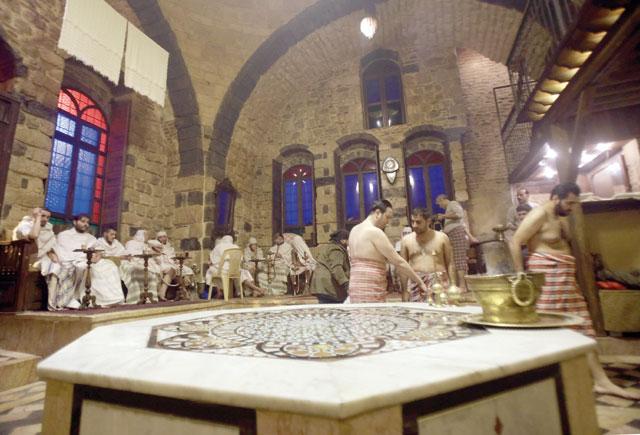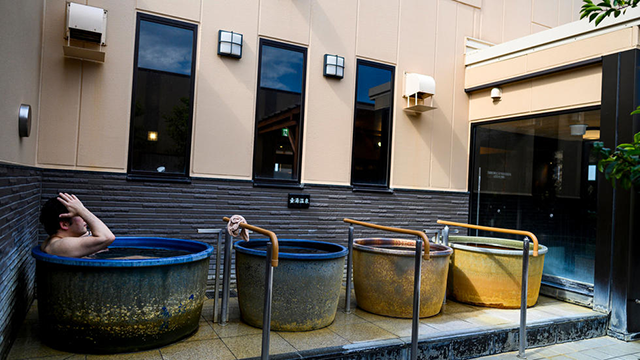You are here
Syrians, an old solution to water shortages — the hammam
By AFP - Jan 09,2017 - Last updated at Jan 09,2017

Syrian men visit Al Malik Al Zahir Hammam in the capital Damascus on January 7 as an ongoing water crisis continues due to the fighting between government forces and rebel fighters (AFP photo)
DAMASCUS — Anwar Al Ades has not bathed properly in two weeks because of water shortages in Syria's capital Damascus, but all that is about to change at the city's oldest bathhouse.
The elegant Al Malik Al Zahir hammam dates back to 985 AD but is experiencing unprecedented demand since fighting cut water supplies to the capital, leaving millions facing shortages.
"I haven't bathed since the water to Damascus was cut off," 34-year-old Ades told AFP as he changed into a towel.
"Since then, the priority for the water we do get has been washing up and drinking. Bathing has become a secondary thing, particularly since it's winter."
Most of capital's water supply comes from the rebel-held Wadi Barada region, some 15 kilometres northwest of Damascus.
Fighting has raged in the area for weeks, damaging key water infrastructure, and continued despite the start of a nationwide truce on December 30.
That has left up to 5.5 million people in Damascus and its suburbs facing water shortages, the United Nations says.
But the crisis has proved something of a boon for Al Malik Al Zahir, one of many traditional bathhouses in Damascus, which has its own private water supply from a well.
Hammams have a long history in the Middle East and Turkey, but in recent years Damascenes have tended to visit them only on special occasions, with just a dozen or so customers visiting Al Malik Al Zahir each day before the water crisis.
Clientele has doubled
"I haven't been to the hammam for 12 years, since my wedding day," said Habib Issa, a 32-year-old hairdresser, relaxing in the reception area.
"I have a contingency plan for electricity and fuel shortages, but it never crossed my mind to make one for water," he said.
"At this rate, we'll need a plan for when there's no air left in the city!"
Like many bathhouses, Al Malik Al Zahir is divided into three key sections, with its heart the central steam room.
Inside, a central platform is ringed with little booths, each equipped with taps supplying plentiful hot and cold water, as well as bowls and soap.
Next is the area set aside for massages and scrubdowns by hammam staff, and when the process is complete, customers proceed to the reception area.
The large room is laid out like a courtyard, with an ornate central fountain featuring delicate inlaid tile in the shape of a flower.
The floors are covered with zigzag patterns in white and sand coloured tile, while stained glass windows colour entering light a deep blue or red.
Customers waiting their turn, and those relaxing after a good scrub, lounge on cushioned chairs on an elevated platform that runs around the edge of the room.
Staff deliver tea, water pipes, snacks and dessert as clients unwind under the watchful eye of owner Bassam Kebbab, whose phone rings constantly.
"The number of customers has almost doubled, and the reason they're coming these days is different, now it's a necessity whereas before it was just for leisure," he told AFP.
"We try not to turn any customers away, and we ask people not to linger too long so we can meet the needs of the greatest number of people who want to bathe," he said.
Waiting for water to return
As he moves through the different parts of the hammam, eager customers call incessantly and he books appointments for coming days, apologising to disappointed clients hoping to come the same day.
"I've already cancelled a booking from merchants who wanted to book the whole hammam, extended working hours until past midnight, and bought more soap and equipment to meet increased needs," he said.
But he hasn't increased his prices, still charging an entrance fee of just 1,200 Syrian pounds (around $2.40), with massages and scrubs costing a little more.
"When I walk around and hear people speaking, they're all talking about one subject: how to get water and when things will go back to how they were," Kebbab said.
Abdullah Al Abdullah, 46, was relaxing after his bath in the reception, getting ready to eat the lentil dish known as mujadara, a traditional post-hammam favourite.
"At home, I have shortages of electricity, heat and water. When the power is on, there's no water, and when the water comes, there's no electricity," he told AFP.
"So I had to come to the hammam to find water, electricity and warmth in one place," he said.
Despite his relative youth, he sports a head of completely grey hair, a testament to the hardships of nearly six years of war, he said.
Syria's conflict began in March 2011 with anti-government protests and has evolved into a complex civil war that has killed over 310,000 people and displaced more than half the country's population.
"Half my hair went grey in the first year of the war, the other half in the following years," said Abdullah, an electrician.
"I've lost so many of the basics of life but my family and I just can't stand losing water."
Related Articles
ALEPPO, Syria — The ancient bathhouses of Syria’s second city Aleppo are filling up again, not because of a revived fad, but due to power cu
SANAA — Yemenis go to the Fakhama Bathhouse in the capital Sanaa to relax with steam, scrubs and massages.They also go in search of a
YOKOHAMA, Japan — Masazumi Kato sighed deeply as he lowered himself into a tub at a public bathhouse in a Tokyo suburb, enjoying a return to



















